A Story...
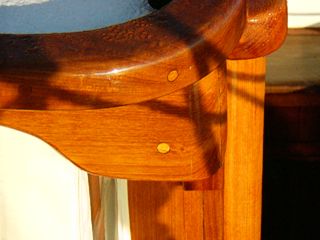
25 Years of Design • Build • Use
A Presentation @ the San Francisco Institute of Architecture
April 13, 2000
Part 2 of 2
Continued from Part 1 of 2
1996 - Cambridge
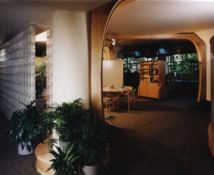 Cambridge is, to date, our best design-build exercise - it, also, has been the most profitable facility we have ever built.
Cambridge is, to date, our best design-build exercise - it, also, has been the most profitable facility we have ever built.
This project was created in 30 days - from raw concrete to a 100 clients in a DesignShop experience - over Christmas and New Years. The design-build team first sat down together with a blank sheet of the footprint on the 4th of December and the facility was in operation on the 3rd of January. The schedule was a design constraint along with all the many other considerations. We were also very constrained by cash - in effect, we had only a $100,000 of the $750,000 capital required, in addition to the build-out budget allowed in the lease for leasehold development, to furnish and fully equip 12,000 square feet of DesignShop space.
We accomplished nearly $700,000 in gross revenues the first month of operation, return of capital in 6 months and a bottom line net profit of one million, from rentals alone, in the first year of operations. At the end of the second year, we sold the facility to a business partner for about our basic capital investment.
In effect, the entire facility required $100,000 of cash and paid the rest of the capital requirements and subsequent expenses off out of immediate cash flow and turned a profit within the first year.
This is a case where the ability to build fast and meet deadlines, driven by market opportunity, totally drove the design-build process and allowed us to do something that otherwise would have been financially impossible.
As one of 20 places where DesignShop services are provided on a regular basis, Cambridge is still regarded as one of the best. Economy, quality control, rapid-time-to-value are not enemies of architecture, they are intrinsic tools for acquiring it.
| Use Economics as a design tool - this is not merely designing to an arbritary budget. Develop concepts over long periods of time; implement specific projects very fast. The greater the time to build, the greater exposure to risk a project has. The time-to-value aspect of design/build/use can be critical to project economics. Designing the economic basis of a work may be as creative as the design of the project itself. Cambridge is easily one of the most pleasant to-be-in environments we have ever built - one that many still regard as our best - yet, it was a production engine and a great money maker. There were no compromises between these aspects of the Program. The schedule actually drove the design-process. Design determinations that normally take days and weeks took only minutes and hours. The Team had to know how to design-build - and, had to trust one another completely. Materials and components were selected that we available - somewhere. In order to get what we wanted, in time, we had to buy from all over the US. The local Boston supply market was not sufficient. It should be noted, however, that the decision to build the project under the starting economic conditions caused great dissent in MG Taylor executive ranks. In fact, it and the Palo Alto project, cost us a senior manager who could not see how the economics would work. The “go” decision was made by those who knew what they could do and who had the responsibility to go do it. This is rarely the case in the typical corporate environment. The traditional decision process makes building effectively nearly impossible in typical circumstances. When the floor above the Cambridge facility was develop two years later by the organization we sold it to - even with our help and with many of the original team in place - it took 9 months and a significantly greater budget to create the equivalent kind of environment. The difference? The corporate process that set the terms by which the design/build team worked. This is a clear example of how important the client is in the creative process of architecture. |
| Designers | Matt Taylor, Bryan Coffman |
| Sponsor | Matt Taylor |
| Design Team | Matt Taylor, Bill Blackburn, Inga Hanks, Don Pendelton |
| User/Owner | MG Taylor Corporation/KnOwhere Stores |
| Architect | Inga Hanks, iDesign |
| Builder | Modern Continental |
| PM | Don Pendelton |
| System | AI WorkWalls and WorkFurniture and technical systems design; Tim Siglin |
| Location | Cambridge, MA |
| Year | 1996 - 1997 |
1997 - Palo Alto KnOwhere Store
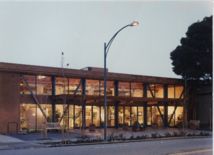 Our largest environment and most extensive modification of the structural shell to date.
Our largest environment and most extensive modification of the structural shell to date.
This is our first (nearly) full venue KnOwhere Store: retail and display areas; large group process facilities; office hotelling and incubation spaces; team work areas; extensive computer; web-publishing and printing facilities; a server farm that supports a myriad of different client and partner organizations. More than anything we have done, this facility stands for our Brand. It presents us, and our philosophy, to the world of Silicone Valley.
The numerous activities housed @KnOwhere constitute a wide variety of functions to be placed in one largely open 20,000 square foot footprint. This makes a good test bed for understanding how, often competing, activities can be managed in a way to get tremendous space utilization and throughput.
The Store functions as the MG Taylor Regional Office, the center of the KnOwhere Store corporate functions, offices for a number partner and startup firms, as well as, the away-from-office creative space for a number of Silicon Valley Trade Marks. In addition, we do a number of large-scale DesignShop and Work Shop events for up to a 100 participants. Most importantly, it is steadily evolving toward it’s primary function which is to be a Node where physical location and virtual space intersect to create a “hot spot” of the emerging Network Economy.
(Finding the space - an important story).
The community context around this KnOwhere Store is rapidly changing. This circumstance drove both design and the choices that were made in terms of what to build now and what to build later. The Store is place in the center of the Midtown Shopping District of Palo Alto. This district is just beginning a renascence and is expected to be much like the Palo Alto downtown in a few years. This means lots of shops, cafes, sitting areas, walks. A lively gathering place, as well as, shopping area. Since we rebuilt the old (empty of 6 years) department store into KnOwhere, this process has accelerated.
The Store front is designed to embrace the street with folding back glass doors and a large patio that penetrates deeply into the interior. Today, this is used little and the interior activities are largely screened off by Pods and WorkWalls. The light and view out, however is used. In time, progressively, the interior use will change and two things happen in concert: as the KnOwhere Store evolves into a “Market” for KnowledgeWorkers and as the Midtown District becomes a “street” mall. This evolution is a factor of KnOwhere’s and the communities financial evolution. The transition of the KnOwhere Store will be seamless because to was design to happen from the beginning and because we did not overbuild in the first place.
The Palo Alto KnOwhere Sore is not finished. In fact, it is about 50% done. This is so for two reasons. First, we had only the financial means (barely!) to get the basics completed. It is our policy, in addition, to build enough to start operations and then evolve the environment, afterward, based on real experience - not theory. Alexander points out in the “Timeless Way of Building,” that buildings that evolve over time become more human and useful. This is a difficult practice in the modern world of Building Departments and Bank Mortgages. However, a form of this way can be practiced at sufficient scale to have an impact.
How people react to this environment is both interesting and gratifying. The vast majority love it. Their reaction is astounding to me. First, that they like it as much as they do, and second, that there are so few spaces like it given the way that people do respond. Third, that it so difficult, often, to get organizations to build this way.
Since the end of 1997, when the Palo Alto facility was built, several buildings in the area have been remodeled. The most extensive of which is a Starbucks recently completed next door. The City of Palo Alto turned down their first plan because “it did not come up to the standard of the KnOwhere Store.” Starbucks adapted the KnOwhere Store’s basic idiom and treatment even down to the major colors. The two buildings, together will set a strong trend and may even establish a “look” of the neighborhood that later works will emulate.
| July 22, 2001 Update Across the street was an existing building that is a nice work that is said to be designed by a FLlw apprentice. It was originally a bank and was converted (poorly) to a pastry shop and overgrown with landscaping so the character of the building could not be seen. Recently, it was purchased and remodeled again. We talked to the new owner and encouraged him to catch our idiom in every possible way while restoring the integrity of the original design. This picture, taken yesterday, begins to show the results. Now, the corner is anchored by three works: knOwhere, Starbucks and the new (yet unnamed) ex-bank/pastry shop. This is beginning to bring PLACE to Midtown. A Pattern Language is beginning.
|
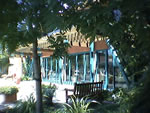 | 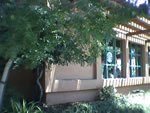 | 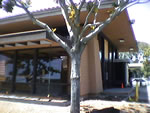 |
| knOwhere | Starbucks | ex-bank/pastry shop |
The Palo Alto facility was a great risk for us and huge investment. However, today, virtually all our opportunities are coming through this portal. Every day, more and more, the environment is pulling people in who are responding to the ambiance of the space. It is beginning to stand for something - a way of being and working, The environment is a catalyst for people moving from desire (of a better way) to action.
| Build buildings to evolve - they will anyway. Help the process along. This means you have to understand the region and district around you. Employ “Weak Signal” Research. Bet on the future - not just the present. Build based on long-term sustainable economic principles. Don’t overbuild. Build enough to get open and meet the basic mission of the work. Establish a budget and process for a slow-paced continuous improvement and adaptation of the building. Avoid the high rent areas and find the places where movement towards renewal is beginning. Reuse existing structures whereever possible and to the extent possible. Reference the historical context of the areas - put your work in time and place and the evolution of that place. Seek to be a positive architectural influence on the immediate area. Create an Armature that others can build off of. It is more important to do this (in this kind of circumstance) than to build a radical statement that does not lend itself to extension through future projects. There are other contexts in which it is appropriate to build an idiosyncratic work. Take a prudent risk when the opportunity to get in early at a fraction of the future cost presents itself. This way, you prosper from the value creation of your own effort. Building at the back end of the development cycle is like buying stock at the “high.” We were not ready, financially, to do this project. If we did it today (December 2000) it would cost us easily 25 to 40% more. A “good” financial statement could not get the opportunity today that a “bad” one was able to do three years ago. Be adaptive with real estate and economic cycles. |
| Designer | Matt Taylor |
| Sponsors | Gail Taylor Matt Taylor Roxy Rapp, Developer |
| Design Team | Matt Taylor Clair Bill Blackburn Inga Hanks |
| User/Owner | MG Taylor Corporation/KnOwhere Stores |
| Architects | John Norway , Architect of Record iDesign |
| Builder | CEO Construction |
| PM | Glen McFearson |
| System | AI: WorkWalls and WorkFurniture and technical systems design Media Consultant: Tim Siglin |
| Location | Palo Alto, CA |
| Year | 1996 - 1997 |
1998 - CHP Management Center
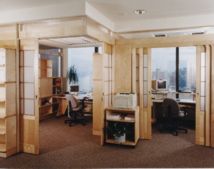 Continuum Health Partners is a large health care provider in New York City. This facility is their Management Center built adjacent to their Executive offices on the 19th floor overlooking the Hudson River.
Continuum Health Partners is a large health care provider in New York City. This facility is their Management Center built adjacent to their Executive offices on the 19th floor overlooking the Hudson River.
This facility house what we call a NavCenter and the planning staff of this large regional hospital organization. It combines offices and open collaborative spaces in an unique way. We designed many projects, since 1980, that did this but this turned out to be our first large scale integration of these modalities. Also, the CHP Center was the first full implementation of our Cube Office system.
This was also one of our worst build experiences where everything when wrong that could go wrong. We eventually got it done with great pain and suffering a much lighter checkbook and some lessons learned. In the end, it was worth it and the quality of the space shines through every day.
| Beware when you go into a new town - the locals can clean your clock. This happened to us here although we thought we had secured enough local knowledge through associates. Don’t assume that a member of the team, having performed well in the past, will perform well in every circumstance. We dropped the ball on this project and I can not place the blame on anyone - it was the consequence of everyone not putting enough energy into context and team health. |
| Designer | Matt Taylor |
| Sponsors | Peter Kelly, Janette Simms |
| Design Team | Matt Taylor, Inga Hanks, Bill Blackburn |
| User/Owner | Continuum Health care |
| Architect | iDesign |
| Builder | Modern Continental |
| PM | Mike Pentelton |
| System | AI WorkWalls and WorkFurniture and technical systems design |
| Location | New York, New York |
| Year | 1997 - 1998 |
1997 - 2000 EY ASE Centers
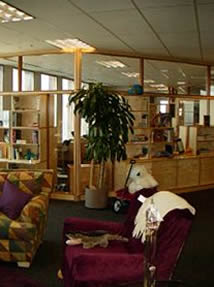 From 1996 and ongoing, a number of ASE Centers have been built by E&Y to perform DesignShop processes in support of their clients. The MG Taylor Trade Dress was an integral part of the IP we Licensed to E& Y who, predominately, use their own architects to design their environments. We have collaborated with their design staffs to various degrees on various projects. AI has been the major supplier for WorkWall systems, WorkFurniture and, as shown on the left, including the CubeOffice system used in Atlanta. ASE Centers have been built in the US, Europe, Asia and Australia. Their permanency factor ranges from a RDS level to those employing highly developed lease hold improvements depending on requirements and the maturity of the local market. Starting in 2000, EY and it’s new parent firm Cap Gemini have started to drift away from the MG Taylor Trade Dress and to employ a wider network of designers and vendors. The results of this are yet to be assessed in regards the impact on the processes employed in these works.
From 1996 and ongoing, a number of ASE Centers have been built by E&Y to perform DesignShop processes in support of their clients. The MG Taylor Trade Dress was an integral part of the IP we Licensed to E& Y who, predominately, use their own architects to design their environments. We have collaborated with their design staffs to various degrees on various projects. AI has been the major supplier for WorkWall systems, WorkFurniture and, as shown on the left, including the CubeOffice system used in Atlanta. ASE Centers have been built in the US, Europe, Asia and Australia. Their permanency factor ranges from a RDS level to those employing highly developed lease hold improvements depending on requirements and the maturity of the local market. Starting in 2000, EY and it’s new parent firm Cap Gemini have started to drift away from the MG Taylor Trade Dress and to employ a wider network of designers and vendors. The results of this are yet to be assessed in regards the impact on the processes employed in these works.
| a |
| Designer | AI/EY Design Team |
| Sponsor | EY Design Team |
| Design Team | Bill Blackburn, Angi Dillon, |
| User/Owner | E&Y ASE |
| Architect | n/a |
| Builder | AI |
| PM | |
| System | AI WorkWalls and WorkFurniture |
| Location | Atlanta, Georga |
| Year | 1999 |
For the Atlanta ASE
1999 - Borgess NavCenter and Armature System
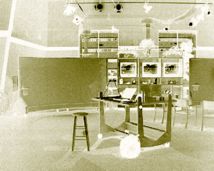 The Borgess facility was built inside an existing gymnasium. This provided us with one of the largest single-span open spaces we have ever had to work with.
The Borgess facility was built inside an existing gymnasium. This provided us with one of the largest single-span open spaces we have ever had to work with.
The result is an 8,000 square foot facility that that be totally reconfigured in a mater of a few hours - and it can be done by the end-users. It does not require a “priesthood” of teckies to configure the space. This means power, video, sound capture and playback all can be connected and disconnected as required to complete rearrange the WorkFurniture. All of these technologies have “plug and play” capability at the furniture and walls themselves, at the overhead trellises that make up part of the Armature system and back at the technology closet.
A few week ago, at a 7 Domains Work Shop at Borgess for 10 MGT client and affiliate organizations (where we teach and transfer our System and Method), we demonstrated this point by completely deconstructing the space. When the participants came in they found the entire environment in neat piles along with a copy of our Patent Pending. They were given two and one-half hours to assemble the environment in a way appropriate for the process to follow. They did it with time to spare.
The Borgess space illustrates what is possible when the footprint is unencumbered by columns. A much greater density and freedom of arrangement is possible. These factors compensate far more than the extra costs associated with structures that will do this.
| a |
| Designer | Bill Blackburn |
| Sponsor | Terri xxx |
| Design Team | Bill Blackburn, xxx, xxx |
| User/Owner | Borges Health |
| Architect | xxx |
| Builder | xxx |
| PM | Bob Kraska |
| System | AI WorkWalls and WorkFurniture |
| Location | Kalamazoo, Michigan |
| Year | 1999 |
1999 - Magic Window
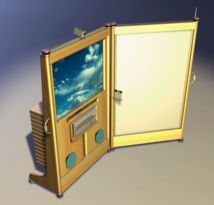 Magic Window is our first product based on the functionality shown in the 1982 concept sketch. It is one measure of how far technology has come in less than 20 years.
Magic Window is our first product based on the functionality shown in the 1982 concept sketch. It is one measure of how far technology has come in less than 20 years.
With the MagicWindow and the Bat System we are introducing a new generation of highly sophisticated environment components that can “plug and play” with various “armature” aspects of the larger structure.
In time, the entire user-experienced environment will be available from the factory allowing fast setup, flexible arrangements and rapid reconfigurations - all this while providing good Pattern Language and serious architectural values.
The MagicWindow went from concept to a working prototype supporting real work in 30 days.
Video conferencing has consistently been the promise that failed. This is because of the primitive level of the technology, the lack of a proper architectural setting and totally false assumptions about the in-place work processes that are utilized.
There are two ways (at least) to get at this and both have to do with scale and interface issues. The basic problem is that the design approach and application of video conferencing has derived from television rather than theater, and, from a passive understanding of both. The scale is too small. To be effective, the sounds and images have to be multimedia, large, ubiquitous, hands-free and dynamic - they have to be environmental.
Our work deals with these scale issues by the way we integrate media and display into the larger armature and with products like MagicWindow which integrate and scale-up numerous desktop technologies while adding mobility. In both cases, the technology has architectural presence. In both cases, the work modality is active. In both cases, the technology does not constrain human movement nor the style of interaction. In both cases, the technology does not get in-between those that are engaging in dialog and work.
| a |
| Designer | Paul Lyons, lead; Bill Blackburn, Matt Taylor, concept |
| Sponsor | Pat Gibson, Bill Blackburn |
| Design Team | Paul Lyons, Eric Ginson, Sean xxx, Brian Ross, Bill Blackburn |
| User/Owner | AI |
| Architect | Not determined |
| Builder | Not determined |
| PM | Not determined |
| System | AI WorkWalls and WorkFurniture and Proximal Systems |
| Location | Mobile |
| Year | 1999 |
2000 - Foundation II Series
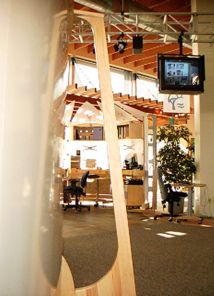 Over a 20 year period we developed a number of components: the WorkWalls, Pod and Cube Office systems, and many pieces of WorkFurniture that each support various specific tasks. From the start, the adaptability and mobility of these components was stressed.
Over a 20 year period we developed a number of components: the WorkWalls, Pod and Cube Office systems, and many pieces of WorkFurniture that each support various specific tasks. From the start, the adaptability and mobility of these components was stressed.
Now, we are addressing several design issues: Maximum “plug and play” one component to another; Maximum flexibility of wiring control (connecting and disconnecting) by the end-user; Maximum integration between the components so that a wide variety of unique areas can fit in an armature that ties it all together; Radically reducing the number of sub-component pieces for ease of manufacturing; Simplifying the shipping and erection processes. This has required a complete redesign of our entire product line to remake it into a single system that can provide a near-infinite number of solutions.
The introduction of different materials, finishes and fabrics - as well as - custom details allows a high level of individual branding for clients who require it. The risk associated with a “system approach” is that you succeed and then spontaneity and freedom are lost. “Nothing fails Like Success.” It is better to think of our approach as a “meta-system” that can respond equally well to both universal and local challenges.
The present scope of the “system” is wall-to-wall and floor-to-ceiling. The goal is to consistently be able to provide the finished product - design, build, move-in - in a 30 day period of time.
After perfecting this level of the system, the next step will be to start developing the same approach with the “box” itself. The structure and architectural context of contemporary office buildings and campuses has certainly reached a dead end. They are now the modern version of 1950’s tract housing. It is time for us to take on this scale of development because the constraints that come with the buildings are limiting both the range and the quality of the solutions made possible within them.
| a |
| Designers | Paul Lyons, Bill Blackburn, Matt Taylor |
| Sponsor | Bill Blackburn |
| Design Team | Paul Lyons, Bill Blackburn, Brian Ross, Pat Gibson, Matt Taylor |
| User/Owner | AI |
| Architect | n/a |
| Builder | AI |
| PM | Paul Lyons, Brian Ross |
| System | AI WorkWalls and WorkFurniture |
| Location | n/a |
| Year | 1999 - 2000 |
2000 - Detroit Edison
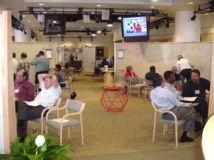 Detroit Edison is a good example of how the collaboration process, between all ValueWeb members, works in our organization. The project is also a good example of using the Internet to facilitate the design-build process. In addition, how the facility was planned and brought about provides a better model for the practice of architecture than the usual traditional approach.
Detroit Edison is a good example of how the collaboration process, between all ValueWeb members, works in our organization. The project is also a good example of using the Internet to facilitate the design-build process. In addition, how the facility was planned and brought about provides a better model for the practice of architecture than the usual traditional approach.
Detroit Edison contacted us about a project that is key to their people strategy and long range viability. They had seen one of our environments, searched and found us on the www and called to find out if their space could be adapted this way. They brought a drawing of their foot print , their facilities architect and the person who owned the project to a one day fly-in-fly-out visit at the Palo Alto KnOwhere Store. This gave us, in actuality, about 6 hours together.
In that time, we reviewed their program, the potential of their space and developed three layout sketches of the space: a Zone diagram, a Pattern Layout and a proof-of-concept floor plan. As we were in one of our facilities, we had both the facilitation of the work and demonstration capability - we were able to adjust the environment we were working in to illustrate the ideas we were discussing. We did not have to explain what we do and why we do it - we merely had to do it. By the time they returned to Detroit, their work was posted to a web-page so they could review it and work further with their colleagues.
The next step was to do a 7 Domains Audit of the entire project. This was accomplished a few weeks later in our Hilton Head facility. About 30 participants from came - inside Stakeholders and their architectural team. In three days the performance specification of each Domain were established, as well as, a schedule and budget for all elements of the program. The actual physical environment is, of course, just one of these Domains. The 7 Domains Audit put the architecture in context and provided the architect with a rich body-of-knowledge that otherwise is either missed or takes days and days to acquire by the interview method.
A week later, the facilities architect and the selected project architect returned to Palo Alto and we designed the project in two days. We worked with AI remotely as we did this. In the process, a new piece of WorkFurniture was created (the usual way we get new pieces into the line). Again, by the time the team returned to Detroit all the work was documented on the web.
Next, Susan, the project owner, asked why should they wait for a long and complex build-out to get started? Within 10 days a small RDS was in place with KnowledgeWorkers and the work began. Months later, after the space had been cleared of occupants, remodeled and setup, it was a smooth transition to using the new environment.
The Detroit Edison people were active design collaborators from the beginning. The usual barriers between architect, facilities and technical people were largely broken. Transfer of our work-processes and IP started immediately - on the very first day. We brought our VISION of the new work place to our client and worked collaboratively neither dominating nor being subordinate - a partnership created this space.
| Design fast - then go through multiple iterations again and again. Within hours of meeting, we had a proof-of-concept design that made it all the way to a built artifact. Many refinements were made along the way. This process made others active collaborators - something impossible in a “batch” process design style. |
| Designer | Matt Taylor |
| Sponsor | Sue Hollabaugh, Jim Noaciki, Shirley Meeker |
| Design Team | Matt Taylor, Jim Lucky, Bill Blackburn, Bob Kraska, Jim Noaciki |
| User/Owner | Detroit Edison |
| Architect | Jim Lucky |
| Builder | |
| PM | |
| System | AI |
| Location | Detroit, Michigan |
| Year | 1999 - 2000 |
The Future
2002 - Bay Area Studio for Matt Taylor
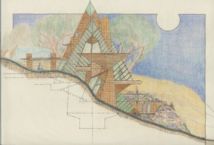 Bay Area Studio is to house my practice of architecture which I will be expanding, in 2002, to a nearly full-time occupation.
Bay Area Studio is to house my practice of architecture which I will be expanding, in 2002, to a nearly full-time occupation.
This work will be the sum of my 44 years exploring architecture - what is it, how to build it, how to apply it and how to practice it.
From this place, I intend to establish a global practice that rests on collaborative processes and redesigned methods of documentation, drawing and contracting. A new practice model that will build on the precepts, tools and methods - the experiences - outlined in this presentation.
The objective of this practice is to do a small number of cutting-edge works that continuously explore new architectural ground. It is intended that this will be done with a different design-build team each project as the work will be distributed globally. The Studio, therefore, has to support this kind of practice.
In doing this, a different kind of work-environment will be created as demonstration of the necessary components and capacities required to make new work-environments at scale.
Most likely - perhaps not - this will be my first opportunity to reunite the structural shell and the larger landscape with interior work spaces. There is a great deal both new and old to explore here. The scale of most work environments has fostered an unfortunate tendency to lose intimacy with the landscape. What we are seeing - being built at a tremendous rate and scale - is asphalt, parking, cold, dull boxes and stale interior formula combined - a forced, dry result.
People think inside these environments that dominate the workplace today; they see reality as framed by these environments. They exist - hour after hour, day after day - in an artificial, detached, denuded shell divided into pigeon holes that preaches separation - not integration; parts mentality - not system; cheap, exploitive economics - not quality, art and the ability to sustain. The patterns necessary to human happiness and productivity are stripped away. So are the conditions conducive to physical health.
What is left is shelter without sheltering; functionality without function; decoration without art. Is it a wonder that people act as they do? The modern corporate organization is the last vestige of the Medieval mind set; the modern office building is the last vestige of the 19th Century work-process organization. How many people would work this way if they were independently wealthy?
What is the impact of millions driving to work - every day - and “working” this way? Walk through this 12 hour experience from home to office to home. What dominates the mental field? What captures the eye? What occupies the ear? What textures and smells stimulate the senses? Would you design this experience deliberately? What is the critera that drives this result? It this good?
| Build smaller, high quality, adaptable, Earth-friendly spaces that inspire. Don’t accept as a definition of the “practical” something that automatically leads you away from what promotes human values and straight forward common sense. A lot of the theories out there have little basis in fact. Remember that architecture is not a visual art - it is an experiential art. It is the context, within which, the greatest amount of human life is lived. There is only one valid standard by which architecture should be judged and that is Nature Herself. Any less a criteria is a compromise that cannot be justified. Find out what Nature does and use that knowledge to generate principles of work - copying Nature is little better than copying the architect next door. It shows you have good taste but won’t get the job done. Observe how people really react and work in these environments - don’t rely on what they say the like. People report on what they know. What they know is shaped and dominated by the built environment in place. We will not get a significantly better one by fixing the existing ones. Be practical. Have a way to building every element in your design. Design things to be built. Beware architecture that results primarily from photograph feedback loops. Pictures cannot tell. They cannot capture experience. Much of modern architecture is just show - no substance. Post Card stuff. Once the “hit” is gone, there is nothing there. |
| Designer | Matt Taylor |
| Sponsor | Matt Taylor |
| Design Team | Not determined |
| User/Owner | Matt Taylor |
| Architect | Not determined |
| Builder | Not determined |
| PM | Not determined |
| System | Not determined |
| Location | San Francisco Bay Area |
| Year | 2000 design; 2002 build (estimated) |
The Future
2004 - Xanadu
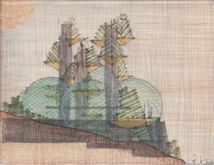 Xanadu was development as a joint project concept between MG Taylor and a technology company spin-off . It was developed by me, from an old idea, to be the “End State Model” for the purpose of focussing thinking on the Trade Dress and BRAND essence of this new push-the-state-of-the-art project. It is a recreation and next generation of what the Joint Venture partners have been thinking about and working toward for many years. Working back from “THERE” a series of environments were to be built - starting with a “HERE” RDS drawn from present capabilities and practices. Each project was to be progressively more sophisticated and larger until full functionality could be achieved. This is a heuristic process and feedback, in this way of working will guides the team to the final expression. It was expected that four or five iterations would be necessary to get to Xanadu - or something like it. There being progressively more “Xanadu” in each one is how this can be done. What actually emerges may be a great deal like the concept - or not. But the essence will be there if the process is kept in place.
Xanadu was development as a joint project concept between MG Taylor and a technology company spin-off . It was developed by me, from an old idea, to be the “End State Model” for the purpose of focussing thinking on the Trade Dress and BRAND essence of this new push-the-state-of-the-art project. It is a recreation and next generation of what the Joint Venture partners have been thinking about and working toward for many years. Working back from “THERE” a series of environments were to be built - starting with a “HERE” RDS drawn from present capabilities and practices. Each project was to be progressively more sophisticated and larger until full functionality could be achieved. This is a heuristic process and feedback, in this way of working will guides the team to the final expression. It was expected that four or five iterations would be necessary to get to Xanadu - or something like it. There being progressively more “Xanadu” in each one is how this can be done. What actually emerges may be a great deal like the concept - or not. But the essence will be there if the process is kept in place.
At the present time (December 2000), the project is on hold due to the technology company’s corporate priorities unrelated to the project itself. The future is uncertain and Xanadu may go back on the shelf to wait another opportunity.
The concept, however, has great appeal and applicability - it has been well received in the short time of it’s present incarnation.
Each of the units that cantilever off the three vertical core towers is about the scale of my Bay Area Studio. Conceptually, the Studio Project can be seen as a partial prototype of this aspect of the Xanadu project. Xanadu also derives from and combines elements from my 1970s work which explored self-contained, multi-use and “meta” structures of various kinds, as well as various Geodesic dome configurations. This rendition of Xanadu is not a mega structure in size but it is in configuration, self containment and site orientation. The base that Xanadu sits on is a 300 foot square. Four of the 5 spheres are 150 feet in diameter and the center one is 190 feet. The towers are about 350 feet high. There are several platforms that tie the three towers together at various levels - inside the domes these house different work areas and support facilities. Above the domes, the platforms create open-air landscaped gardens.
This is a nearly all glass building. Like the Bay Area Studio, a variety of energy management strategies will be employed. This structure will be a net producer of energy.
To build a structure of this type, economically, will require a radically different way of building as I discuss elsewhere. In this project, function, form and way-of-building are far more closely coupled than with conventional work. Again, the Bay Area Studio will be a small scale prototype in terms of the design-build method.
As with the Bay Area Studio project, only on a much larger scale, this configuration provides the opportunity to craft each space so that it meets the exact needs of the function. This can be done in terms of access, viewpoint, light, orientation and so on.
The work, thematically, is a direct expression of its use. The layout, literally, is a built artifact of the work-process algorithm which forms the basis of the venture. Users of the environment move thorough the space as their work progresses - each area, therefore, can be adjusted and set as required. Different groups can be accommodated, simultaneously, affording the exact degree of privacy and interaction as appropriate. The commons are accessible by all creating a place of re-creation and synergy.
Note: Xanadu had not been put on paper in this form and was not shown at the April presentation.
It is added here to add “completness” to the Story.
| Keep going back to old ideas and ahead to future ones. Blend these expressions, together, in the creation today-focused work. Old ideas, new ideas and present circumstances create a rich resource to draw from - let them dialog with one another. In commercial architecture, part of the time and place concreteness of the work can be a clear expression of the brand essence and Trade Dress associated with the enterprise. Architecture is universal and local - both aspects have to have equal weight. The work functions of the building can be explicit expressed in the work without losing future adaptability. |
| Designer | Matt Taylor |
| Sponsor | OIP Yeam |
| Design Team | Not determined |
| User/Owner | Not determined |
| Architect | Not determined |
| Builder | Not determined |
| PM | Not determined |
| System | Not determined |
| Location | Not determined |
| Year | 2000 |
More Future
Starting in 2002
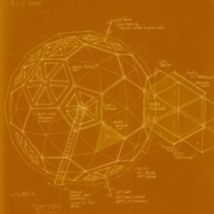 Of course, there is more than this. There is the-forever-with-us afforadable housing mess, issues of sustainibility and ecology, and even if a Planet is the best place to build a high-density industrial cilivization.
Of course, there is more than this. There is the-forever-with-us afforadable housing mess, issues of sustainibility and ecology, and even if a Planet is the best place to build a high-density industrial cilivization.
You may want to check out MLU, Domincle, EcoSphere, SnowFlake and “Bootstrape to Space” to get a flavor of this.
The entire scale and scope of HABITAT (for all species) has to be re-conceived. There are many, many valid, tested alternatives out there ready to be put to work. Unfortunately, too often, their developers and advocates too see their one approach as the solution to all of the economic, social and ecological solutions. This rubs against Nature which has a strong bias for diversity. It is the MIX of these strategies and the totality of how they will be deployed that really counts. It is addressing this issue that a great deal of my future architectural efforts will be focused. In doing this, I will employ the tool-kit of Management Centers, KnOwhere Stores and NavCenters that has consumed my creative efforts over the last couple of decades. The larger architectural agenda was set aside - but never forgotten.
| Designer | Matt Taylor |
| Sponsor | Not determined |
| Design Team | Not determined |
| User/Owner | Not determined |
| Architect | Not determined |
| Builder | Not determined |
| PM | Not determined |
| System | Not determined |
| Location | Not determined |
| Year | Not determined |
My Work
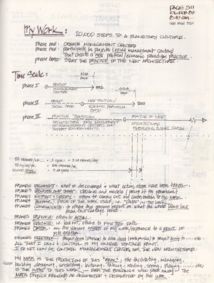 My work in this process, on one hand, is consistent with my starting goals and values and on the other almost completely different than I would have predicted in 1956.
My work in this process, on one hand, is consistent with my starting goals and values and on the other almost completely different than I would have predicted in 1956.
In the creation of these environments I have acted as a system integrator of a ValueWeb. Typically, I set the parameters and performance specifications of a project and, through collaborative iterations of work, facilitate an emergent result far more effective than any work controlled by a single individual can be. Sometimes I actually execute the preliminary design - more often not even that. Sometimes I am engaged in the field supervision process - more often, not. Sometimes I design a piece of furniture - more often, not. My most consistent role is that of user of the system and method we have created - and, as a user, a key feedback loop in the process. Concurrent with this, is my role as inventor and educator.
In addition, I have been the key articulator of the ideas to the marketplace. This is an important function in the process of bringing a nascent idea to fruition - and, very much a “CEO” role in the modern corporation structure.
In February 1983, as I thought about how the “detour” associated with staring MG Taylor would ultimately fit with my architectural goals, I designed a road map (Page 511 - MGT Notebook) for my next 40 some-odd years - this has turned out to be amazingly accurate. The page is scanned above.
This Page described the strategy of DOCUMENTATION (see: the 10 Step Process Model): “20,000 Steps to a Planetary Culture.” It proposed that my Notebooks (now electronic) would document my experiences in FRAMES (pages) at a certain rate: 22 Frames a week which would equal a “cycle” (a little over 3 Frames a day). 52 Cycles a year (1,144 Frames) times 17 and a half years (to 2000) equaled the 20,000 steps. The idea was that it was possible to articulate key concepts and solution-sets at - that level of granularity - and, as documentation of doing examples of the ideas, create a significant influence leading toward a better world.
Well, here we are. Not exactly a Planetary Culture, nor an equal and free one, but a lot closer than in 1983. What is needed is in place - if we choose to use it and use it well. What is (and should be a “Planetary Culture” is subject to a great deal of legitimate debate (and hopefully) good design.
Further, this Model divided the 17 plus years into three Phases: Phase I “Develop Management Centers” - to 1992 (3,248 days); Phase II “Develop Social Base (to 1990 +/-) - New Political/Economic Paradigm Birth” - to 2000 (6,168 days); Phase III “Practice Transition Architecture Through Development of Management Centers and Support Environments - to 1998 +/-) “Practice of New Architecture: REBUILDING OF PLANET EARTH” - starting at the turn of the Century (best case 1999, medium 2000, worst case 2001).
Page 511 specified what these Frames (pages) should do: “Frames DOCUMENT: what is discovered & what action steps have been taken. Frames DESCRIBE & SHOW: designs and models (pieces of the paradigm). Frames INSTRUCT & SPECIFY: steps to be taken to carry out my contribution to the work. Frames BECOME: pieces of the work itself; i.e. “pages” in the book. Frames COMMUNICATE: this person’s report on what the whole looks like from this vantage point. Frames PROVOKE: others to action. Frames EDUCATE: i.e. lead out others to find their path. Frames CENTER: all the various aspects of my work/experience to a point of integration. Frames FEEDBACK: project doing (physics) to idea cloning (metaphysics) to... etc. All that I own or control is my unique vantage point. I do not own or control Management Centers or the new architecture.”
“My WORK is the production of this “BOOK;” the facilitating, managing, building, designing, consulting, lecturing, talking, reading, seeing, playing... Etc; is the INPUT to this work - even the buildings will pass away - the metaphysics remains as documented & distributed by this WORK.”
This Agenda was - and is - an ambitious undertaking. And, not something to be done as a single individual - thus ValueWebs. It also is a dangerous agenda if misconstrued and abused. The rebuilding of a Planet, as example, a dangerous notion. The fact is, however that - like it or not - Planet Earth is a human artifact (and has been for a long, long time). We are going to do it well or poorly. Even “returning” it to some mythical “pristine” state (which is impossible) is an act of building (rebuilding) an artifact.
There is no direct evidence, with any of this, if these efforts of mine have made any beneficial contribution to anything much less a wide spread new way of working or a better architecture or culture - planetary or otherwise. You never know. The important things is to keep building. And to to keep finding better ways to do it. In the end, I think what counts is ART.
As my duties as CEO of MG Taylor give way to something else, over the next couple of years, I intend to return more to my design roots. However, because of the last 25 years experience, I will never return to the kind of design practice I once held as my goal.
Even with my Studio Project, which is the most thoroughly designed and intimately personal work I have undertaken in 25 years, my task will be to design a concept, system and process of design-build. Each subsystem component of this work will be contracted on a performance based design-build agreement. By doing this, each part of the building can be developed to its highest level of art. This is, in actuality, simply a codification of the way I have built for years. In the case of the Studio project, it will be a deliberate exercise design to create a new practice model.
Note: Some of the materials supporting “More Future” and “My Work” was not shown at the April presentation.
It is added here to add “completness” to the Story.
| Conceive the bigger picture - little steps may be safer but usually don’t matter. The work is nearly the same to make anything a success - it might as well be what you want. Lay out a plan; if it does not seem absurd at first sight it is most likely not long enough in its view nor bold enough in its execution; if the first steps always work as designed - beware! If it is a bold plan, many will be needed to do it. Get clear on your role. Avoid distractions (some of them can look real good). Stick to the agenda until you have reason to change it. DOCUMENT you progress - “if it ain’t documented, it ain’t science” is the way that Robert Heilein put it. You cannot properly navigate without documentation. Go back to that documentation - often. Make it part of your living present. Find the QUEST within you - nothing else will do. It is there. It cannot be denied without consequence. Think through to those “unintended” consequences. Create good work for others. Be an effective employer of knowledge worker talent. Create opportunity. Seek to build an expanding, unbounded, freer, more equable future - this is the basis of human life and the architecture to support it. |
The Future of Architectural Practice
The architect will become the System Integrator of a complex design-build-use process. A typical architectural practice will be global in scope. Collaboration will be the norm. The traditional bidding process will be out. Drawings and the entire method of representing the design and building process will be radically altered.
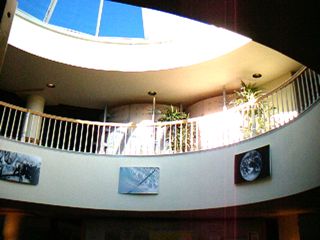
There will be many practice models in the future but I expect some themes to be present in all of them including a new relationship, based on collaboration, between the architect, other design-build professionals and client. The “collaboration” that typically takes place, today, is not what I mean. Not only relationships will be different but the entire method of contracting will change. ValueWebs will replace the inefficient, complex, redundant, adversarial, temporary organizations that design, manufacture and build today.
The Internet will be a ubiquitous tool of this new practice method. Simulation and modeling technology will be common. The factory and field will be intimately linked with the design office and client environment. Insurance, financing, inspection and certification agencies will be linked in real-time.
Buildings will be accomplished in a fraction of the time that they are today and significant cost reductions will be accomplished by eliminating the massive non-value-added work that is performed today.
This will not just be the application of Internet and computer technologies to improve and streamline the existing process - the process of making architecture, itself, will fundamentally change. It is the process that leads to today’s results - technology augmentation, if applied blindly to present processes will lead only to linear improvements and, in some cases, just accelerate failure.
These business process and technology augmentation changes will lead to a quantum leap in the quality and affordability of the typical architectural project. Great works of architecture, in the past, were built by those who could afford them and who had the patience and skill to procure them. There is a critical need to bring this level of result to a broader number of people and organizations. This will happen - it is the great opportunity ahead. It will happen, however, only when the way of building is re-conceived - it is not simply a design issue - it is a work-process issue.
Conclusions
In is not a simple thing to look back on 25 years of work for the purpose of talking about the future. This has been a long quest. Like any quests, it can turn out differently than what was in mind at the beginning. There can be unintended consequences.
However, a real quest always leads you to someplace new - someplace better than you had in mind at the beginning - if the process is a good one. And that is the greater value. There is never a guarantee that a quest will be comfortable. We can talk about the future of architecture from “HERE” - however, if we are working right the result we be far greater than today’s imagination can dream.
There is a wonderful push-pull required to succeed with innovation. On one hand you have to be in the market and be sensitive to what it is. On the other hand you cannot simply give it what it “wants.” It will almost never ask for disruptive innovation - just improvement of what already exists. If you lean too far to one side or the other of this equation - you will fail.
The key word is balance. The key challenge is knowing what that is. High frequency, low magnitude experiments are necessary to find the zone appropriate for accomplishing genuine, sustainable advancements. Innovation is a high contact, extreme sport.
The future cannot be predicted. It is necessary to be good at detecting “Weak Signals.” The future, however, can be made - and that is the exciting prospect.
Go to Part 1 of 2 for the beginning of this story
Matt Taylor
San Francisco
April 13, 2000

SolutionBox voice of this document:
VISION • STRATEGY • EVALUATION
posted April 13, 2000
revised July 22, 2001
• 20000413.162817.mt • 20000417.80643.mt • 20000425.164951.mt •
• 20000508.125722.mt • 20000514.21168.mt • 20000602.14130.mt •
• 20000611.71926.mt • 20000629.153213.mt • 20000715.180358.mt •
• 20000716.184713.mt • 20000719.101221.mt • 20000731.13243.mt •
• 20001125 348601.mt • 20001223.128730.mt • 20010722.554198.mt •
(note: this document is about 90% finished)
Copyright© Matt Taylor 2000
Aspects of the work shown and described are patent Pending by iterations
ASE is a Trade Mark of E&Y LLP.